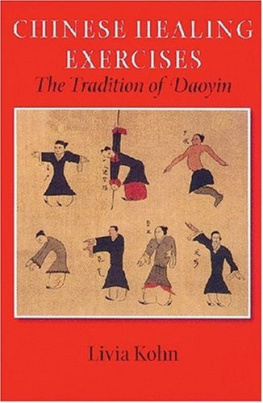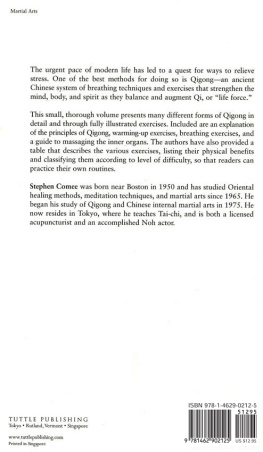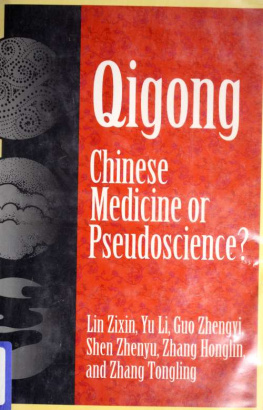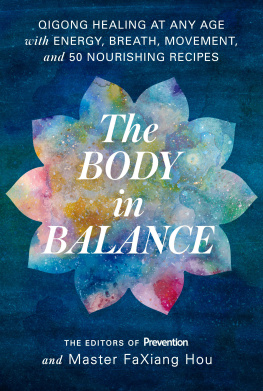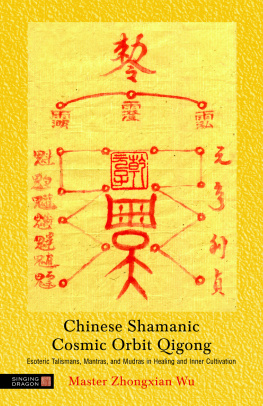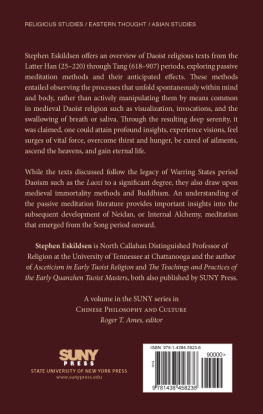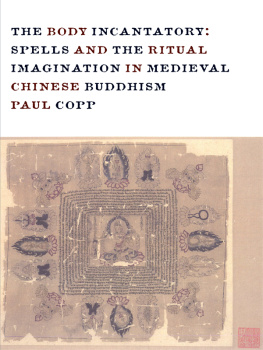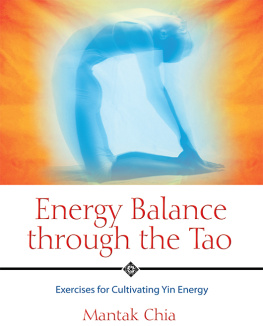Chinese healing exercises : the tradition of Daoyin / Livia Kohn.
p. cm.
Includes bibliographical references and index.
ISBN 978-0-8248-3234-6 (alk. paper) ISBN 978-0-8248-3269-8 (pbk. : alk. paper)
1. Dao yin. 2. Breathing exercisesTherapeutic use. 3. Hygiene, Taoist. I. Title. II. Title: Tradition of Daoyin.
RA781.85.K64 2008
615.8'36dc22
2008009183
University of Hawaii Press books are printed onacid-free paper and meet the guidelines for permanenceand durability of the Council on Library Resources
Designed by University of Hawaii Press production staffPrinted by The Maple-Vail Book Manufacturing Group
Fig. 1: Map of China.30
Fig. 2: Look up and shout. 38
Fig. 3: The Bear Amble. 39
Fig. 4: The bamboo slips of the Stretch Book. 42
Fig. 5: A Daoist with magical powers subduing a tiger. 66
Fig. 6: A practitioner working with the qi while lying on the back. 75
Fig. 7: Purifying talismans of Highest Clarity. 91
Fig. 8: A Highest Clarity practitioner visualizing and invoking the gods. 94
Fig. 9: A portrait of Master Redpine dressed in leaves. 99
Fig. 10: A Daoist sitting up and stretching his arms. 112
Fig. 11: A Highest Clarity practitioner connecting to the Sun. 117
Fig. 12: Organs and energy channels in the body. 125
Fig. 13: Sun Simiao, the King of Medicines. 131
Fig. 14: The original text of On Preserving Life.135
Fig. 15: Sima Chengzhen, the twelfth patriarch of Highest Clarity. 148
Fig. 16: A Daoist practicing healing exercises matching Sima
Chengzhens prescription.153 Fig. 17: The Tiger Frolic. 167
Fig. 18: The seasonal exercise for the summer solstice. 169
Fig. 19: The immortal Dongfang Shuo grasping his toes. 173
Fig. 20: The First Brocade: Beating the Heavenly Drum. 182
Fig. 21: Mao Xuanhan Conquers the Dragon and Tiger. 186
Fig. 22: A sequence of Shaolin qigong. 191
Fig. 23: The Taiji diagram. 194
Fig. 24: The white hair sequence. 208
Fig. 25: Getting ready for Sunday qigong practice at a Hong Kong Daoist Temple.215
Fig. 26: A statue of Jigong, the mad monk. 216
Fig. 27: Advertising a Daoyin retreat through the British
Taoist Association. 225
Acknowledgments
This work grew over many years of study and practice, both academically and in various exercise traditions. I am indebted to many teachers, supporters, and fellowseekers.
First, I would like to thank qigong masters Roger Jahnke, Michael Winn, Karin Srvik, Frank Yurasek, and Paul Gallagher as well as taiji quan master Bede Bidlack for providing pertinent instruction in Chinese physical practicesboth traditional and modernin a large variety of media: in person, through video, on audiotapes and CDs. Their work over a number of years greatly increased my personal experience of the Chinese modality of physical healing and enhanced my understanding of qigong and taiji quan in a way that books never could.
Next, I am deeply grateful to my many yoga teachers over the years, most notably Patricia Walden and Annie Hoffman, who provided thorough instruction in the Iyengar method and raised my awareness of the works of B. K. S. Iyengar, an invaluable resource for understanding the medical benefits of body bends and stretches. I would also like to thank my teachers Yoganand Michael Carroll andMartha Abbot, as well as other staff members of the Kripalu Center for Yoga andHealth, for the in-depth training in yogic thinking, the thorough exposition of anatomy and physiology, and the compassionate assistance in actual practice they provided during my yoga teacher training at Kripalu in 2002. More recently, I would like to acknowledge Ana Forrest, yoga master extraordinaire, for her outstanding work in transforming bodies with apparently simple movessomething her yoga has much in common with the Daoyin practices studied in this book.
On a third level, I wish to thank John Loupos, healer and martial arts instructor of Cohasset, Massachusetts, for not only helping me with a bursitic shoulder but in the process introducing me to Hanna Somatics, thereby opening a completely new way of looking at exercise and the body that has pervaded the work on this book. By extension, I am much indebted to the late Thomas Hanna and his extraordinary work on the body. Not only transforming my own practice, his guidancein his book and in numerous patiently recorded audio sessionshas helped to create a clearer image of what needs to be done to a body to effect relaxation and healing. His theory of the three key reflexes has been essential to
ix
xAcknowledgments
my understanding of why Chinese practitioners do what they do and how they come to claim specific results for certain practices.
In a more academic and theoretical vein, I would like to thank several of my graduate students for doing outstanding work and raising my awareness and understanding of different aspects of physical practice and healing. Stephen Jackowicz, highly gifted acupuncturist and graduate of Boston University in 2003, did outstanding work on the absorption of qi, successfully applying information from medieval Daoist materials to a twentieth-century patient. His in-depth analysis of how medieval Chinese understood the workings of the inner body and his thorough medical and therapeutic analysis of the process of qi-absorption have greatly influenced my interpretation of this rather advanced aspect of Daoyin practice.
Another graduate student whose work and help were invaluable was Shawn Arthur, who graduated from Boston University in 2006. His dissertation is on the dietary and fasting techniques of Daoists and modern qigong practitioners, examining them both on the basis of traditional concepts and in terms of modern physiology and pharmacology. His work on fasting and the replacing of ordinary food and drink with qi provided me with great insights into the Chinese understanding of the bodys structure and the role of breathing and diet in the context of healing exercises. Besides aiding this project with his knowledgeable expertise, Shawn has also been invaluable in assisting the actual manuscript preparation.
A third graduate student who provided knowledge and inspiration is Heidi Nugent at the Union Institute, Ohio. She has just completed a pathbreaking dissertation on breath, its understanding in different cultures, and the various ways people use (and abuse) it to create health or sickness. As she moved along in her in-depth study, she has greatly increased my understanding and awareness of breathing physiology and the role it plays in traditional forms of healing.
Beyond the background practice and information necessary for the completion of this book, I also received enormous support and encouragement in the course of manuscript preparation. First, in the summer of 2005, I was given the great chance to present my findings on Chinese healing exercises to experts at the annual convention of the National Qigong Association (NQA) in Boulder, Colorado. During a whole-day workshop on Daoyin and a two-hour seminar on Animal Forms, participants in good cheer actually performed the exercises I had translated from ancient texts. In subsequent discussions, they provided extensive feedback and substantive insights into the effects of the exercises, the connection to modern practices, and the best terminology to use. Until then I had, in imitation of European scholars, translated the term daoyin as gymnastics, but workshop participants made it very clear that in the United States the word has too much of an athletic connotation to be ap

